#galerie rené block
Photo

From: 'A Sweet Wall'. An Activity by Allan Kaprow, [Potsdamer Platz, Berlin], Galerie René Block, Berlin, November 11, 1970 [Archiv Block, Edition Block, Berlin]
#art#fluxus#happening#performance#photography#allan kaprow#galerie rené block#edition rené block#edition block#archiv block#1970s
41 notes
·
View notes
Photo



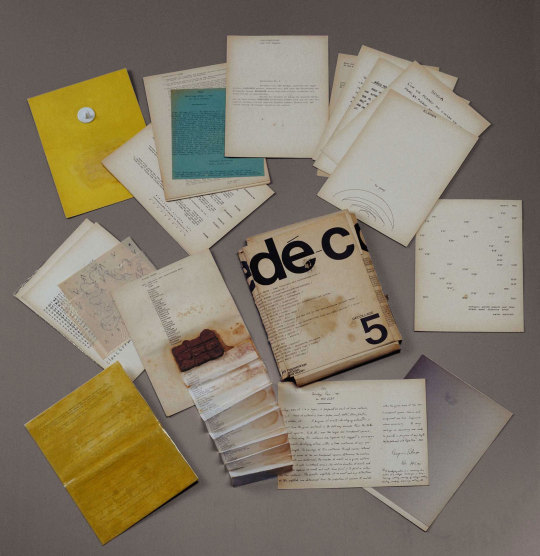
Wolf Vostell (DE, 1932 - 1998)
_
WOLF VOSTELL 2 dé-coll/age-happenings BERLIN 1965. Artist's book: screenprints on laminated paperboard with metal hand-screw clamp. Page: 21.5 × 10.7 cm. Publisher: René Block - Printer: Hochacker, Wuppertal
The Gilbert and Lila Silverman Fluxus Collection Gift
FONDAZIONE BONOTTO - Vostell, Wolf - Dé-Coll/age Happenings
Wolf Vostell | Dè-Coll/Age (1966) | Artsy
https://www.moma.org/collection/works/172870?artist_id=6191&page=1&sov_referrer=artist
https://collections.geneve.ch/mah/oeuvre/2-de-collage-happenings-edition-1-rene-block-galerie-berlin/gevbaaa20023566
#Wolf Vostell#artist's book#book binding#minimal#brut#design#modernism#paper#assemblage#box#collage#visual communication
9 notes
·
View notes
Text
Igor and Svetlana Kopystiansky: Incidents (1996/7)
Igor and Svetlana Kopystiansky: Projects
Igor and Svetlana Kopystiansky: The Day Before Tomorrow (1999)
Svetlana Kopystiansky: Works and Projects
Igor Kopystiansky: Works and Projects
Igor and Svetlana Kopystiansky: Archive Documents
Video Works. Vimeo
Video Works. YouTube
Bibliography
Books by Igor and Svetlana Kopystiansky
Works by Igor and Svetlana Kopystiansky are represented in permanent collections of the Museum of Modern Art, Metropolitan Museum and Whitney Museum of American Art in New York, Art Institute of Chicago, Museum of Fine Arts, Houston, Smithsonian American Art Museum, Washington D.C.; Henry Art Gallery in Seattle; Zimmerli Art Museum, Rutgers University, New Jersey; Musée National d'Art Moderne Center Pompidou, Paris; Musée d'Art Moderne de Saint-Etienne Métropole, France; Tate Modern, London; Art Gallery of New South Wales, Sydney; Museo Nacional Reina Sofia; Folkwang Museum in Essen; Ludwig Forum for International Art, Aachen; Berlinische Galerie; Museum für Moderne Kunst, Frankfurt am Main; MUMOK Vienna, Austria; Centre for Contemporary Art Luigi Pecci, Prato, Italy; Frac Corsica, France; MOCAK, Museum of Contemporary Art Krakow, Poland; Muzeum Sztuki Lodz, Poland (Svetlana); Muzeum Sztuki Lodz (Igor); The Lithuanian National Museum of Art. Vilnius, Lithuania.
Archives by Igor and Svetlana Kopystiansky are located at the Centre Pompidou, Kandinsky Library.
Works by Igor and Svetlana Kopystiansky were exhibited at venues including: Henry Art Gallery, Seattle (2017-2018); MFAH Texas (2017); MoMA, New York (2012); Center Pompidou, Paris (2015, 2011, 2010, 2009); Tate Modern London (2010, 2011-2012), Metropolitan Museum, New York (2013-2014, 2010-11, 2001,1997); Center Pompidou Metz (2011-2012); Smithsonian American Art Museum (2015, 2010-11); Art Institute of Chicago, (1996, 1997-1998, 2008); The Museum of Contemporary Art, Chicago (1999); Scottsdale Museum of Contemporary Art, Arizona (2005); Fine Arts Center UMass, Amherst, Massachusetts (2005); Musée d’Art Moderne de Saint-Etienne, France (2010); Tate Liverpool (1999); Whitechapel Art Gallery, London (1999); MMK Frankfurt/Main (2011, 2010, 1999); Kunsthalle Düsseldorf (1992, 1994, 1995); Kunstmuseum Düsseldorf (2000); Folkwang Museum, Essen (2000); Sprengel Museum Hannover(2002); Kunsthalle Fridericianum, Kassel (2005-2006, 1999); Deichtorhallen Hamburg ( 2011-2012), Kunsthalle zu Kiel (2011-12); Kunst-Werke Berlin (1999); Reina Sofia, Madrid (1994-1995); S.M.A.K. Gent (2009); GAMeC, Bergamo (2011); Museum of Modern Art EMMA, Finland (2007); AGNSW, Sydney (1992, 2003, 2005, 2008, 2009); Kunsthalle Krems, Austria (2012); MARCO, Vigo, Spain (2007); MUMOK, Vienna, (1989) and others. Igor and Svetlana participated in international exhibitions including Sculpture Projects Münster 1997 (Svetlana), Documenta 11 (2002) and biennials in Venice 1988 (Aperto curated by Dan Cameron), Sydney 1992 (curated by Anthony Bond), Sao Paulo1994, (curated by Nelson Aguilar), Istanbul 1995 (curated by René Block), Johannesburg 1997 (curated by Okwui Enwezor), Lyon 1997 (curated by Harald Szeemann), Liverpool 1999, Triennial of Small Sculpture” Fellbach, Germany 2004 (curated by Jean-Christophe Ammann), Triennial of Small Sculpture Stuttgart 1998 and others.
#kopystiansky#tate modern#igor and svetlana kopystiansky#center pompidou#moma#gamec bergamo#svetlana kopystiansky#metropolitan#Igor Kopystiansky
1 note
·
View note
Text
Igor and Svetlana Kopystiansky: Projects
Igor and Svetlana Kopystiansky: Incidents (1996/7)
Igor and Svetlana Kopystiansky: The Day Before Tomorrow (1999)
Svetlana Kopystiansky: Works and Projects
Igor Kopystiansky: Works and Projects
Igor and Svetlana Kopystiansky: Archive Documents
Video Works. Vimeo
Video Works. YouTube
Bibliography
Books by Igor and Svetlana Kopystiansky
Works by Igor and Svetlana Kopystiansky are represented in permanent collections of the Museum of Modern Art, Metropolitan Museum and Whitney Museum of American Art in New York, Art Institute of Chicago, Museum of Fine Arts, Houston, Smithsonian American Art Museum, Washington D.C.; Henry Art Gallery in Seattle; Zimmerli Art Museum, Rutgers University, New Jersey; Musée National d'Art Moderne Center Pompidou, Paris; Musée d'Art Moderne de Saint-Etienne Métropole, France; Tate Modern, London; Art Gallery of New South Wales, Sydney; Museo Nacional Reina Sofia; Folkwang Museum in Essen; Ludwig Forum for International Art, Aachen; Berlinische Galerie; Museum für Moderne Kunst, Frankfurt am Main; MUMOK Vienna, Austria; Centre for Contemporary Art Luigi Pecci, Prato, Italy; Frac Corsica, France; MOCAK, Museum of Contemporary Art Krakow, Poland; Muzeum Sztuki Lodz, Poland.
Archives by Igor and Svetlana Kopystiansky are located at the Centre Pompidou, Kandinsky Library.
Works by Igor and Svetlana Kopystiansky were exhibited at venues including: Henry Art Gallery, Seattle (2017-2018); MFAH Texas (2017); MoMA, New York (2012); Center Pompidou, Paris (2015, 2011, 2010, 2009); Tate Modern London (2010, 2011-2012), Metropolitan Museum, New York (2013-2014, 2010-11, 2001,1997); Center Pompidou Metz (2011-2012); Smithsonian American Art Museum (2015, 2010-11); Art Institute of Chicago, (1996, 1997-1998, 2008); The Museum of Contemporary Art, Chicago (1999); Scottsdale Museum of Contemporary Art, Arizona (2005); Fine Arts Center UMass, Amherst, Massachusetts (2005); Musée d’Art Moderne de Saint-Etienne, France (2010); Tate Liverpool (1999); Whitechapel Art Gallery, London (1999); MMK Frankfurt/Main (2011, 2010, 1999); Kunsthalle Düsseldorf (1992, 1994, 1995); Kunstmuseum Düsseldorf (2000); Folkwang Museum, Essen (2000); Sprengel Museum Hannover(2002); Kunsthalle Fridericianum, Kassel (2005-2006, 1999); Deichtorhallen Hamburg ( 2011-2012), Kunsthalle zu Kiel (2011-12); Kunst-Werke Berlin (1999); Reina Sofia, Madrid (1994-1995); S.M.A.K. Gent (2009); GAMeC, Bergamo (2011); Museum of Modern Art EMMA, Finland (2007); AGNSW, Sydney (1992, 2003, 2005, 2008, 2009); Kunsthalle Krems, Austria (2012); MARCO, Vigo, Spain (2007); MUMOK, Vienna, (1989) and others.
Igor and Svetlana participated in international exhibitions including Sculpture Projects Münster 1997 (Svetlana), Documenta 11 (2002) and biennials in Venice 1988 (Aperto curated by Dan Cameron), Sydney 1992 (curated by Anthony Bond), Sao Paulo1994, (curated by Nelson Aguilar), Istanbul 1995 (curated by René Block), Johannesburg 1997 (curated by Okwui Enwezor), Lyon 1997 (curated by Harald Szeemann), Liverpool 1999, Triennial of Small Sculpture” Fellbach, Germany 2004 (curated by Jean-Christophe Ammann), Triennial of Small Sculpture Stuttgart 1998 and others.
#svetlana kopystiansky#igor kopystiansky#smithsonian american art museum#whitney museum of american art#centre pompidou#musee d'art moderne st.etienne#mmk frankfurt#mumok#moma#video art#appropriation art#tate modern#agnsw
0 notes
Text
PROJECTS
Igor and Svetlana Kopystiansky: Incidents (1996/7)
Igor and Svetlana Kopystiansky: The Day Before Tomorrow (1999)
Svetlana Kopystiansky: Projects
Igor Kopystiansky: Projects
Igor and Svetlana Kopystiansky: Archive Documents
Video. Vimeo
Video. YouTube
Bibliography
Books by Igor and Svetlana Kopystiansky
Art works by Igor Kopystiansky are represented in collections of Museum of Modern Art, Metropolitan Museum and Whitney Museum of American Art in New York, Art Institute of Chicago, Museum of Fine Arts, Houston, Smithsonian American Art Museum, Washington D.C.; Henry Art Gallery in Seattle; Zimmerli Art Museum, Rutgers University, New Jersey; Musée National d'Art Moderne Center Pompidou, Paris; Musée d'Art Moderne de Saint-Etienne Métropole, France; Tate Modern, London; Art Gallery of New South Wales, Sydney; Museo Nacional Reina Sofia; Folkwang Museum in Essen; Ludwig Forum for International Art, Aachen; Berlinische Galerie; Museum für Moderne Kunst, Frankfurt am Main; Frac Corsica, France; MOCAK, Museum of Contemporary Art Krakow, Poland; Muzeum Sztuki Lodz, Poland, National Gallery of Art. Museum of the Radvilas Palace, Vilnius, Lithuania.
Archives by Igor and Svetlana Kopystiansky are located at the Centre Pompidou, Kandinsky Library.
Works by Igor Kopystiansky were exhibited at venues including MoMA, New York; Center Pompidou, Paris; Tate Modern London; Metropolitan Museum; Center Pompidou Metz; Smithsonian American Art Museum; Art Institute of Chicago; Scottsdale Museum of Contemporary Art, Arizona; Fine Arts Center UMass, Amherst, Massachusetts; Musée d’Art Moderne de Saint-Etienne, France; Tate Liverpool; MMK Frankfurt/Main; Kunsthalle Düsseldorf; Kunstmuseum Düsseldorf; Sprengel Museum Hannover; Kunsthalle Fridericianum, Kassel; Deichtorhallen Hamburg, Kunsthalle zu Kiel (2011-12); Reina Sofia, Madrid; S.M.A.K. Gent; GAMeC, Bergamo; Museum of Modern Art EMMA, Finland; AGNSW, Sydney; MARCO, Vigo, Spain; MUMOK, Vienna.
Igor Kopystiansky participated in international exhibitions including Documenta 11 (2002) and biennials in Venice 1988, Sydney 1992 (curated by Anthony Bond), Sao Paulo 1994, (curated by Nelson Aguilar), Istanbul 1995 (curated by René Block), Johannesburg 1997 (curated by Okwui Enwezor), Lyon 1997 (curated by Harald Szeemann), Liverpool 1999, Triennial of Small Sculpture” Fellbach, Germany 2004 (curated by Jean-Christophe Ammann), Triennial of Small Sculpture Stuttgart 1998.
An initial inspiration for individual works by Igor Kopystiansky in media of painting and installation reproduced below came from the international avant-garde, DADA and Marcel Duchamp, specially from his ideas of not-direct appropriation. This group of works does consist from installations and objects made from appropriated paintings. Appropriated were images by various Western-European painters originally produced from 17th till early 20th century. New paintings were made deliberately in a different size then originals. It reflected the situation when the work of art does function in the society more as a reproduction in a book, as a poster, billboard, or has been viewed at the screen at the cinema when the size of the image is different then the original painting. From appropriated paintings were created objects, installations and environments. This group of works was called (de)constructions.
#Igor Kopystiansky#svetlana kopystiansky#moma#Tate Modern#postmodernism#smithsonian#american art#metropoliitan museum#centre pompidou#Art Institute of Chicago#Appropriation art#art american#whitney museum of american art#smithsonian american art museum
0 notes
Photo
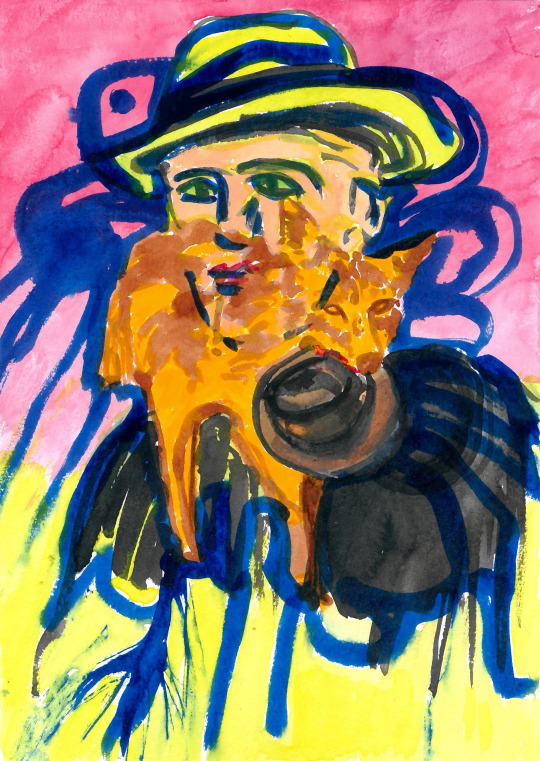
I like America and America likes Me, 101219
#art#kunst#bildendekunst#bildende kunst#ink#drawing#tusche#grafik#joseph beuys#beuys#galerie rené block#new york
3 notes
·
View notes
Photo
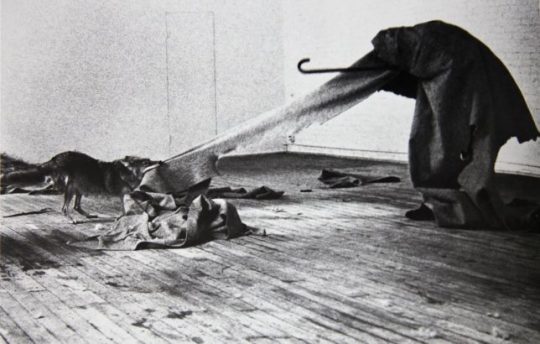
Joseph Beuys
Performance « I like America and America likes me », galerie René Block, New York, 1974
(via 10 choses à savoir sur Joseph Beuys - Magazine Artsper)
4 notes
·
View notes
Photo

👔 Joseph Beuys, Felt Suit, 1970. Felt Suit is a two-piece suit comprising a jacket and a pair of trousers made from coarse grey felt. It was produced in an edition of one hundred identical suits, all produced in the same year. The artist has stated that work can be displayed in any way, although it is usually shown hanging from a wooden coat hanger. The jacket has lapels and three pockets – one on each side of its lower portion and one right breast pocket – and the trousers feature belt loops. There is no lining inside the jacket, nor does it have any buttons, and the seams are machine-woven with grey cotton thread. All of the suits in the edition feature a label on the inside bearing a stamp and the edition number of the work. This work was made by Beuys in 1970, when he was primarily living and working in Düsseldorf, Germany, and the edition was issued by Galerie René Block in Berlin that same year. Beuys commonly wore clothing made from felt throughout his career and in an interview conducted in the year that this work was made he stated that it was ‘tailored after my own suit’. It is not clear exactly how the one hundred suits in the edition were created, nor whether the resulting objects are identical to Beuys’s original garment. However, discussing this work in 1970 Beuys stated that ‘felt is … pressed together usually from hare or rabbit’s hair’, suggesting that one of these may be the material used here. When asked in the same interview how he would like the work to be displayed, Beuys answered: ‘I don’t give a damn. You can nail the suit to the wall. You can also hang it on a hanger, ad libitum! But you can also wear it or throw it into a chest’. The simple, descriptive title of this work emphasises the material used and indicates that the object is a suit – something that usually has an everyday, practical function rather than a creative one. Despite Beuys’s statement that the suit could be worn as a means of displaying it, in the same interview he said that doing so would be impractical since ‘in a relatively short time it’ll lose its shape because felt is not a material which holds its form’. Nonetheless, in producing this work that could serve as a functional object, Beuys may have been questioning the traditional separation between fine art and domestic items. He stated further that when making works which seem to be everyday objects, he hoped that viewers might ‘realize that everyone is an artist, because, many people will ask themselves: “Why don’t I make something like that, something similar.” The sentence “Everybody is an artist” simply means to point out that the human being is a creative being, that he is a creator, and what’s more, that he can be productive in a great many different ways. To me, it’s irrelevant whether a product comes from a painter, from a sculptor or from a physicist.’ Beuys frequently used felt in his work, including in sculptures, installations, and performances. He associated felt with the production of ‘warmth’ and sometimes referred to object-based works involving the material as ‘warmth sculptures’. In 1979 he wrote that he was interested in producing sculptures that emphasise ongoing processes (such as insulation) rather than fixed states because he wanted to show that ‘Everything is in a state of change’, an idea that he linked with the concept of ‘social sculpture’, or ‘how we mold and shape the world in which we live: sculpture as an evolutionary process’
42 notes
·
View notes
Text
BIO
Bartus Ferenc
1974.10.04.
E-mail: [email protected]
Web: https://bartusferenc.blogspot.com/
Tanulmányok
2018-2019 Magyar Képzőművészeti Egyetem, Képzőművész tanár szak
2005-2011 Magyar Képzőművészeti Egyetem, Festő szak
2004-2005 BLOCK ART Kulturális Egyesület-Rajziskola
2003-2004 Dési Huber István Képzőművészeti Kör és Rajziskola
1998-2001 Kodály Zoltán Alapfokú Művészeti Iskola
Tagságok
2011- MAOE
2007- MAMŰ Társaság
2005- BLOCK ART Kulturális Egyesület
1998-2010 Izsó Miklós Képzőművészeti Kör
Művésztelepek
2006 - Nagykáta-Erdőszőlői Művésztelep
2006 - 2016 Jászberényi Art Camp
Díjak, ösztöndíjak
2011 Barcsay-díj
2010 Tóth Menyhért Alapítvány Ösztöndíja
Munkák közgyűjteményekben
Nagykáta Városi Könyvtár Közgyűjteménye
Eszterházy Károly Egyetem Jászberényi Campus Gyűjteménye
Egyéni kiállítások
2018 „Megsemmisült mozdulatok” című kiállítás, Magyar Műhely Galéria, Budapest
2017 „A létezés peremén” kiállítással egybekötött könyvbemutató, Tat Galéria, Budapest
2017 „HYPNAGOG” Nagy Balogh János Kiállítóterem, Budapest
2017 „Rapid Eye Movement” című kiállítás Horváth Endre Galéria,
Balassagyarmat
2015 „Gyermekkori Képzelgések” című kiállítás, Magyar Műhely Galéria, Budapest
2015 „Hasonlóságok és különbségek” című kiállítás, Palota Galéria, Budapest
2013 „KÍSÉRLETEK-ÁTFEDÉSEK” című kiállítás, Nagy Zopánnal. MAMŰ Galéria
2012 „Felszíni Fejtés” című kiállítás, Magyar Műhely Galéria, Budapest
2012 „Mozaik(on)” Nagy Zopánnal és Győrffy Sándorral Kastélykert, Kapolcs
2012 „Bartus Ferenc festőművész kiállítása”, Adeline Galéria, Rákospalota
2012 Barcsay-díjjal kitüntetett művészek kiállítása, Barcsay Múzeum, Szentedre
2011 „Fragmentumok” című kiállítás, Fészek Galéria Herman-terem, Budapest
2010 „On the Road-Úton” című kiállítás, Eckermann Kávéház, Budapest
Csoportos kiállítások
2019
„ÉLŐ MAGYAR FESTÉSZET 2019” Esernyős Galéria, Budapest
„A VÉLETLEN” című kiállítás, Nagykáta Városi Könyvtár, Nagykáta
„ART MARKET BUDAPEST”, MAMŰ stand
„UTOLSÓ RÉTEG III. / UPMOST LAYER III.” Udvarház Galéria, Veresegyház
„FATAL POSSIBILITY” MAMŰ Galéria, MMG Galéria, Budapest
2018
„ÉLŐ MAGYAR FESTÉSZET 2018” Kepes Intézet, Eger
„THE COINCIDENCE” Nagykáta-Erdőszőlői Nemzetközi Művésztelep
MAMŰ, MMG Galéria, Budapest
„10. Groteszk Triennálé” Együd Árpád Művelődési Központ-Vaszary Képtár, Kaposvár
2017
„ÉLŐ MAGYAR FESTÉSZET 2017-A HAL” című kiállítás, Új Budapest Galéria (Bálna)
„CIC” című kiállítás, Erdős Renée Ház, Budapest
„ÚTVESZTŐ / THE MAZE” MAMŰ Galéria, MMG Galéria, Budapest
2016
„XXIII. Miskolci Téli Tárlat 2016” Miskolci Galéria Rákóczi-ház, Miskolc
„A narrátor kommentárja” című kiállítás, MAMŰ Galéria, Budapest
„(L)EHETŐ LEHETETLEN”, Művelődési Ház, Székelyudvarhely
„Ajka tárlat 2016” Nagy László Városi Könyvtár és Szabadidő Központ, Ajka
„ÉLŐ MAGYAR FETÉSZET 2016” Szent Adalbert Központ, Esztergom
„100 éves a DADAizmus”, Vajda Lajos Stúdió, Szentendre
„(L)EHETEŐ LEHETETLEN” Jászberényi Art Camp, Lehel Filmszínház, Jászberény
„Cyber Paradise” Nagykáta-Erdőszőlő Art Camp, MAMŰ Galéria, MMG Galéria
Nemzeti Kulturális Alap beszámoló kiállítása, Várkert Bazár, Déli Palota, Budapest
„President St.”Az Elnök Utcai Művésztelep kiállítása, Bartók 1. Galéria, Budapest
2015
„Halárusok” című kiállítás, MMG Galéria, Budapest
„KIVONAT” A jászberényi Art Camp művészeinek kiállítása, MAMŰ Galéri, Budapest
XXV. ART CAMP Művészeti Szimpózium Jubileumi kiállítása
Lehel Film-Színház, Jászberény
„Édes Európa” Nagykáta-Erdőszőlő Art Camp, MAMŰ Galéria, MMG Galéria, Budapest
„Itt és most – Képzőművészet, Nemzeti Szalon” Műcsarnok-Kunsthalle, Budapest
2014
Magyar Műhely Galéria 10. évfordulós kiállítása, MMG Galéria, Budapest
„Barcsay 25” MűvészetMalom, Szentendre
„(El)tűnő árnyék II” Jászberényi Art Camp kiállítása, Magyar Műhely Galéria, Budapest
„(El)tűnő árnyék” Jászkürt Fogadó Galéria, Jászberény
„A legjobb és a legrosszabb nap” Nagykáta-Erdőszőlő Art Camp, MAMŰ Galéria
„Kép-Tár-Ház” című kiállítás, Szombathelyi Képtár
Novotny Tihamér gyűjteménye. Vízivárosi Galéria, Budapest
2013
„A Művészet a Művészeké?” MAMŰ Galéria, Budapest
„Mint(h)akép II. ”, Ateliers Pro Arts, Budapest
„Határ-esetek” Hegyvidék Galéria, Budapest
XXIII. Jászberényi Art Camp „Mint(ha)kép” című kiállítása, Jászberény
„Péntek 13” Nagykáta-Erdőszőlő Art Camp kiállítása, MAMŰ Galéria,, Budapest
„Idő Függések” A MAMŰ 35 éves évfordulós vándor-kiállítása:
UAP Galéria-Kultúrpalota, Bernády ház, Marosvásárhely
Székely Nemzeti Múzeum, MAGMA, Lábas Ház, Sepsiszentgyörgy
Csikász Galéria, Várgaléria & Magtár, Laczkó Dezső Múzeum, Veszprém
2012
„Szentendre a Palotában” Kultúrpalota, Marosvásárhely
XXII. Art Camp, Jászkürt Fogadó Galéria, Jászberény
2011
XXI. Jászberényi Art Camp „Saját(om)” című kiállítása. K.A.S. Galéria, Budapest
„Tóth Menyhért-ösztöndíjasok 2000-2011” Cifrapalota, Kecskemét
„Szentendre a Gödörben II.” Gödör Klub, Budapest
„Szinkrónia” SILÓ Kortárs Művészeti Központ, Csíkszereda
„Just a moment” Nagykáta-Erdőszőlő Art Camp kiállítása, MAMŰ Galéria
FOGLYUL-EJTETT (Személyes) IDŐ, MMG Galéria, Budapest
2010
„Művésztelepek 2010” MAMŰ Galéria, Budapest
XX. Jászberényi Art Camp „Spiritual Unity”, Jászkürt Fogadó Galéria, Jászberény
„Tabula Rasa” No. I., MAMŰ Galéria, Budapest
VI. Nagykáta-Erdőszőlő Art Camp, MMG Galéria, Budapest
2009
„Újabban” Az MKE Szűcs Attila osztályának kiállítása, Fogasház, Budapest
„Reakció”, MAMŰ Galéria, Budapest
V. Nagykáta-Erdőszőlő Art Camp kiállítása, MAMŰ, MMG Galéria, Budapest
Keller Galerie (Wien)
„Önarckép” című kiállítás, Eckermann Kávéház, Budapest
2008
„Nagy Gábor osztály, a Csongrádi Művésztelepen”, Csongrád
„Jászberényi Art Camp művészei” című kiállítás, Szolnoki Művésztelep-Kert Galéria
XVIII. Jászberényi Art Camp „KÉKZÖLD”, Jászkürt Fogadó Galéria, Jászberény
IV. Nagykáta-Erdőszőlő Art Camp „Meglepő fordulat” című kiállítása
MAMŰ, MMG Galéria, Budapest, Keller Galerie, Bécs
„Áttekintés” című kiállítás, MAMŰ Galéria
„Szabadságra mentem csoport" kiállítása, VAM DESIGN, Budapest
„Izsó Miklós Képzőművészeti Kör „50-ik évforduló” Városi Kiállítóterem, Kazincbarcika
„Jászberényi Art Camp művészei” című kiállítás, MAMŰ Galéria, Budapest
2007
„Új MAMŰ Tagok” című kiállítás, MAMŰ Galéria, Budapest
Baudelaire A „Romlás virágai ” pályázat kiállítása, Petőfi Irodalmi Múzeum, Budapest
Miskolci Montmartre Fesztivál kiállítása, Miskolc
„FORRÁS” XVII. Jászberényi Art Camp kiállítása, Aba-Novák Kulturális Központ, Szolnok III. Nagykáta-Erdőszőlő Art Camp kiállítása, MAMŰ Galéria, MMG Galéria, Budapest
„KOMP csoport” kiállítása, Vajda Lajos Stúdió, Szentendre
„Bázis Filmfesztivál” Rakétabázis, Zsámbék
„Primőrmalőr” című kiállítás, MAMŰ Galéria, Budapest
2006
„TOLLBAMONDÁS” XVI. Jászberényi Art Camp Tisza Mozi Galéria, Szolnok
II. Nagykáta-Erdőszőlő Art Camp kiállításai MAMŰ Galéria, MMG Galéria, Budapest
„Fotógrammok” című kiállítás, Eckermann Kávéház, Budapest
2005
„Tanítványok” című kiállítás, MAMŰ Galéria, Budapest
1 note
·
View note
Photo

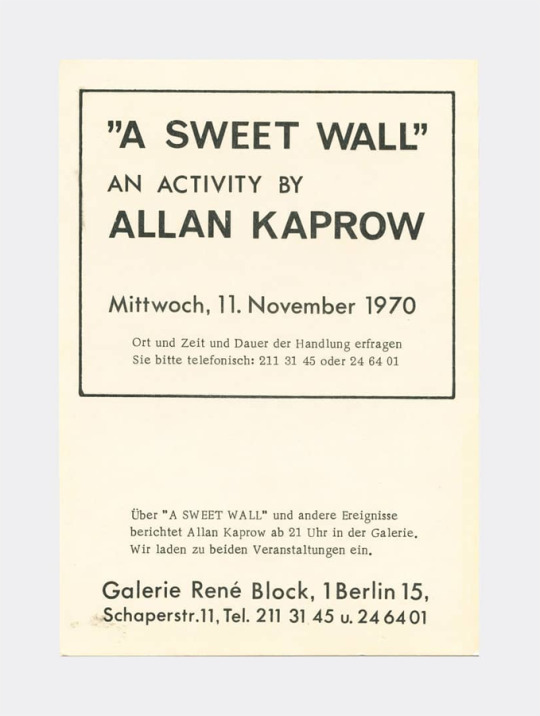
'A Sweet Wall'. An Activity by Allan Kaprow, [Potsdamer Platz, Berlin], (invitation card), Galerie René Block, Berlin, November 11, 1970 [Archiv Block, Edition Block, Berlin]
#graphic design#art#fluxus#happening#performance#invitation#invitation card#allan kaprow#galerie rené block#edition rené block#archiv block#edition block#1970s
19 notes
·
View notes
Photo
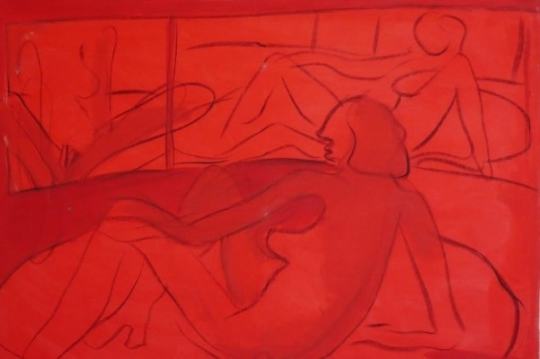
Neuer Post auf ART@Berlin https://www.artatberlin.com/ausstellung-karl-horst-hoedicke-koenig-galerie-contemporary-art-kunst-in-berlin-art-at-berlin/
Karl Horst Hödicke | König Galerie | 03.03.-08.04.2018
bis 08.04. | #1897ARTatBerlin | König Galerie zeigt seit 3. März 2018 die Ausstellung “Frühe Objekte – Späte Bilder” des Künstlers Karl Horst Hödicke, ausgewählt von René Block. K. H. Hödicke hat am 21. Februar seinen 80. Geburtstag gefeiert. Seine frühen Einflüsse reichen vom F...
4 notes
·
View notes
Text
Windows
“Windows are metaphors for seeing, windows are like drawings of a building.” INTERVIEW with Rik De BoeNov 08,2015 - by
Simone Kraft
Belgian artist Rik De Boe (*1964) specializes in black and white charcoal drawings, on identical paper sizes. Many of his works are based on photographic sketches, taken on the road. Back in the studio, De Boe uses these shots as starting points for his drawings. His basic interest is space and architecture – he captures windows, blinds or sections of facades in high-precision drawings.
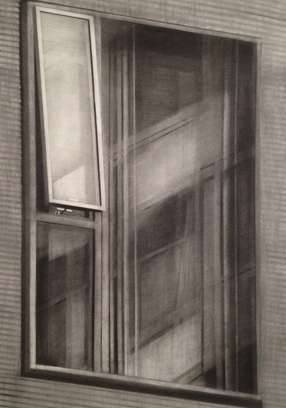
Window, 2012, Kohle auf Papier, 76,5 x 53,5 cm
At the same time his works always revolve around fundamental questions of perception, as if they were snapshots of a continuing exploration of space, which is accompanied by a constant change of scale and perspective.
Rik de Boe is teaching drawing and graphics at the art academy in Brussels and is artistic leader of Voorkamer, an art space dedicated to contemporary art in Lier, which he founded in 1996, together with Peter Morrens. He is represented by Rasche Ripken Berlin and Gallery Sofie Van de Velde Antwerpen.
In an email interview with deconarch.com Rik De Boe tells us about his particular interest in windows, why his sceneries are deserted and lets us delve into his working process.
all illus. (c) Rik De Boe,
www.rikdeboe.be
and Galerie Rasche Ripken,
www.rasche-ripken.de
INTERVIEW
What is it that interests you about architecture? And why the particular focus on windows?
Architecture surrounds us everywhere. I’ll try to make drawings based on what I have seen, what I have experienced. Everything is seen in a certain way, as found images or as real items. Windows are metaphors for seeing, windows are like drawings of a building.
Every window is specific, tells us something – not a big story, but something small that becomes visible to the outside.

Windows, 2012, Kohle auf Papier, 76,5 x 53,5 cm
The drawings are deserted, no inhabitants there. Why?
A nice quote from Andrew Grassie says: ”People are too interesting“.
The viewer is the actor. My window views are my personages. In some recent drawings people are appearing, fragments of people. Most of them are coming from paintings, in the Vermeer series for example.
The only good answer I can give is … because it’s what I do.
”People are too interesting“ – do you agree with Grassie?
It is quite an ironic quote. Rather I like the idea that my drawings suggest a world where people are hidden, sleeping … maybe they are dead or they just left the building? It is not really a happy world that is portraited.
The reflection of the glass in the frames is playing this role, as it disturbs our view of the image and thus you become part of it. In other drawings light reflections play a role, too. Where there is a light, there is a suggestion of people, of life …
Tell us a little more about your work – what are you interested in?
Let me tell you some quotes I consider relevant.
“Re-enacting my own life.”
„The movement of my thought interests me more than the thought itself.“ (Pablo Picasso)
“Let’s just imitate the real, until we find a better one.“ (The Notwist)

Window view with plants (Herne 05/2012), 2012, Kohle auf Papier, 76,5 x 53,5 cm
Maybe I’m looking for images that evoke a similar feeling as if you come home from a long trip abroad and the world that you so trust beholds. I love that strange feeling.
There is no action … point back to an act that has just passed, or an action that is still to come. The props are so meaningful. They have the potential of a story.
So you are ”collecting“ props, you isolate them and transform them into a canvas where a story develops?
The props are blocking the view, vases, flowerpots, reflections … These things act as a reminder of the inhabitants. They let you think about people without seeing them.
But I don’t want to tell a story, because it ends as quickly as it starts.
Where do you find your motives?
Everywhere.
By passing by things, during walks, travelling, museum visits, photographing – not really in a conscious way, sideways and a bit in a hurry, maybe almost uninterested.
A lot of drawing are views seen in an backwards angle – as I am passing things and looking back while walking forwards. When you are seeing something but become aware of it only a fraction later.
Later in the studio the photographs need to rest, and some of them come to my attention when they are ready and worth to become drawings.
How is your working process?
I start by protecting all white areas with sensitive pink tape. Then I draw the most black areas with concentrated charcoal. Working with fingertips and brushes stage after stage, I remove the tape or protected areas between different phases while fixating the drawing with fixative. I continuously move to the white area lifting off the attached tapes, often leaving marks. In the end the paper – and drawing – shows the proces, the history of the making.
Why painting/drawing these sceneries, why not just photographing them?
I am more interested in a tonality which suggests a photocopy rather than a photo or even a drawing.
A drawing is slower.
What possiblities does this offer?

Roomview (München 07/2012), 2013, Kohle auf Papier, 76,5 x 53,5 cm
Developing something in time with errors, doubts and hesitations. The drawings can even appear more real than reality to me, almost as if a world could exist in black and white …
Why art?
“Art is what makes life more interesting than art.” (Robert Filliou)
Are there role models, influences, … which inspire your work?
I like Vermeer, Piero della francesca, Frank Zappa, Georges Perec, Gustave Flaubert, Bach, Palladio, Italia, Domenico Gnoli, Edward Hopper, Leon Spilliaert, Luc Tuymans, John Coltrane, Joey Baron, Andreas Gursky, Peter Zumthors Vals, Breaking Bad, Piet Mondriaan, Miroslav Tichy, James Stewart, Hitchock, Cary Grant, New York, Japan, PJ Harvey, Captain Beefheart, Gerhard Richter, Hall Hartley, Morandi, Andrea Mantegna, Markus Raetz, Bas Jan Ader, René Daniels, Mies Van Der Rohe, Gerrit Rietveld, Mad Men, The Brancaci Chapel, Giotto, Led Zeppelin, Orval Beer, Jacques Tati, Jim Jarmusch Stranger than paradise, Villa Sunflower Marcelisse, Katsura Imperial Villa, Doris Day, Bruce Nauman, Michaël Borremans, John Zorn Massada, Roman Signer, Kolumba Köln, Hercules Seghers, Saul Leiter, Johan De Wilde, Fred Astaire, Caspar David Friedrich, Thomas Huber, Ellsworth Kelley, Agnes Martin, Balthus, Hammershoi Vilhelm, Ed Ruscha, Sigmar Polke, Dirk Braeckman, Fra Angelico, Rogier van der Weyden, Van Eyck, Hiroshi Sugimoto, Karl Blossfeldt, Robert Bresson, Laurel and Hardy, Steve McQueen, Bill Viola, Sonic Youth, Miles Davis …
0 notes
Photo

Der Hase – Koons und Beuys Der Hase – Jeff Koons – Joseph Beuys 1974 fand die Performance „Coyote“ in der New Yorker René Block Galerie statt, in der Joseph Beuys sich mit einem Tier befreundete, das so symbolhaft für Amerika steht wie das Känguru für Australien – und – ich wage hinzuzufügen – der Hase für Deutschland.
0 notes
Link
0 notes
Photo
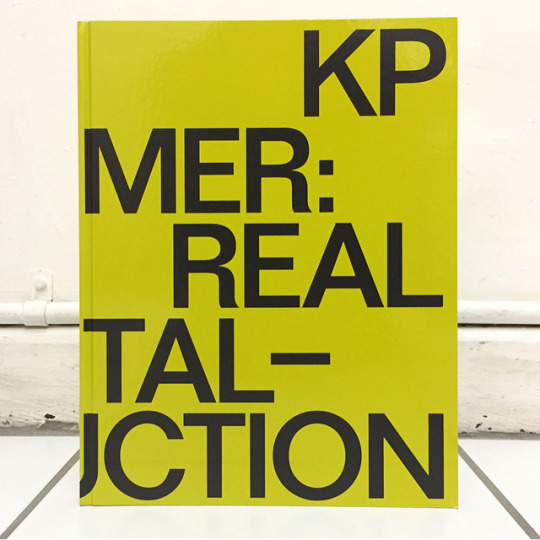
OPEN TIL 5. NEW IN THE BOOKSHOP: KP BREHMER - REAL CAPITAL-PRODUCTION (2018) • This is the first monograph on KP Brehmer to appear in English and the first major publication on the artist since the Museum Friedericianum Kassel catalogue in 1998. • Part of Capitalist Realism – the initiative centred around Galerie René Block in Berlin in the mid to late 1960s, that included fellow artists Sigmar Polke and Gerhard Richter – KP Brehmer is increasingly recognised as a key figure in postwar German art in his own right. • Richly illustrated with previously unpublished archival images as well as more recent exhibition photographs, the texts by leading specialists (Jürgen Becker, René Block, KP Brehmer, Mark Fisher, Doreen Mende, Alex Sainsbury, Kerstin Stakemeier) focus on his practice during the 1960s and 1970s when he was developing his unique graphic representations of capital which anticipate todayʼs ubquitious data visualisation systems. • Available via our website and in the bookshop. • #worldfoodbooks #kpbrehmer #ravenrow #waltherkoenig #reneblock (at WORLD FOOD BOOKS)
0 notes
Text
Joseph Beuys - Coyote : I like America and America likes Me (1974)
New-York : Action qui inaugure l’ouverture de la galerie René Block à New York. Un espace de la galerie délimité par une grille sert de refuge, pendant trois jours, à Joseph Beuys et à un coyote capturé pour l’occasion.
L’artiste ayant décidé de ne pas poser les pieds aux États-Unis avant la fin de la guerre du Vietnam, désire ne rencontrer de ce pays que le coyote, animal sacré, dieu des Indiens, représentant selon lui, "le point névralgique psychologique du système entier des énergies américaines : le trauma du conflit de l’Américain avec l’Indien." C’est en sorcier, par des rituels précis et des gestes ésotériques que Beuys entre en contact avec l’animal. L’artiste repart comme il est arrivé, sans poser les pieds sur le sol américain, le corps roulé dans une couverture de feutre, transporté dans une ambulance, en urgence, vers l’aéroport Kennedy.
0 notes